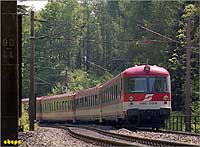 |
|
This
railcar approaches the Rumpler tunnel area. It's the 6010.013, the
same train like shown some images later at the Krauselklause tunnel.
I took this image, because one can compare the differences between
the actual design (2002) and the original version as it was in the
late eighties when the other photo was taken. Watch the missing corner
windows and the not really fitting automatic doors, which were installed
in the meantime (5/2002). |
|
|
|
|
|
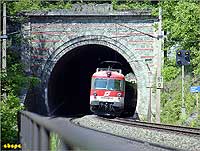 |
|
This
is the valley sided portal of the Rumpler tunnel. The area is rather
difficult to be reached by foot. A railcar passes the tunnel when
rolling down the hill. In contradiction to the image before, the machine
head is in front here. Steering head: 6010 - machine head: 4010 (5/2002). |
|
|
|
|
|
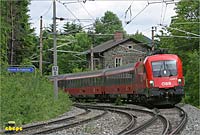 |
|
About
900 m later trains are entering the area of the today unmanned Klamm
Schottwien station. At both station heads turnout connections between
the tracks are placed. This one is located directly in the curve (6/2004).
(top of page) |
|
|
|
|
|
 |
|
The
tracks reache the station of Klamm Schottwien located in a real panorama
section. In a long bend the train approaches the Klamm tunnel. Today
it's heavy to find an open position between the trees (10/2001). |
|
|
|
|
|
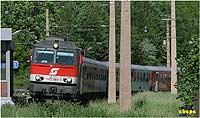 |
|
The
hourly regional train is stopping at the Klamm-Schottwien station.
The train is mainly used by Semmering hikers, but the total seat capacity
is not really often needed (5/2003). |
|
|
|
|
|
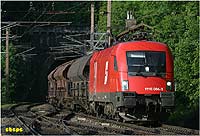 |
|
This
freight train is leaving the Klamm Tunnel downhill. The rather quiet
operating noise of loco 1116.084 is in strong contradiction with the
waggons, which are producing heavy sound (5/2003). (top
of page) |
|
|
|
|
|
 |
|
This
3 Taurus headed train is at the same position as the one on the image
before. Close to the tunnel a former attendant building is visible
and left beside the train a special turnout construction for track
changing opens the Klamm Schottwien station area (6/2004). |
|
|
|
|
|
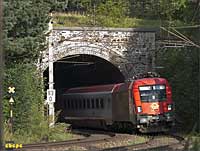 |
|
At
about 6:00 p.m. a Taurus with train IC 631 "Universitaet Klagenfurt"
has reached the uphill exit of the Klamm Tunnel. This Taurus belongs
to the Gysev Company, it is leased from OeBB for 20 years (8/2005). |
|
|
|
|
|
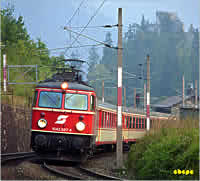 |
|
After
leaving the Klamm tunnel the train gets closer to the Wagner viaduct.
In the background the Klamm ruin and an additional rail attendant
building is visible. Carrying this design release (orange color, corner
windows, large headlights) class 1042 was well known for several decades
(about 1987). (top of page) |
|
|
|
|
|
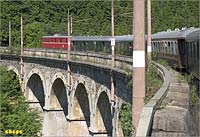 |
|
Because
of the left side traffic, the lookout to viaducts from train windows
is plenty nice when going uphill; here the Wagner viaduct. In order
to enable open object view to the Semmering world heritage for passengers,
a lot of trees were felled in many places along the rail track in
2004 (5/2005). |
|
|
|
|
|
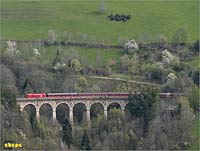 |
|
Because
trees are still leafless beginning of May, one can recognize that
the Wagner viaduct is a two storey building. With 9 upper and 5 lower
arches and 142 m length the building is the second largest of the
two storey viaducts (5/2005). |
|
|
|
|
|
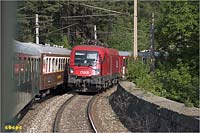 |
|
Train
crossing close to Gamperl viaduct. It seems that the track distance
which is built here, is the minimum which is still operational without
problems (5/2005). (top of page) |
|
|
|
|
|
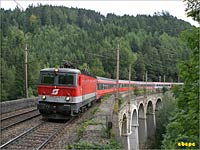 |
|
About
800 m uphill of the Wagner viaduct the Gamperl Graben viaduct chains
on. Even in 2004 the 150 years anniversar of the line, the responsible
railroad people did not decide to remove ugly plants from the parapets.
(10/2004). |
|
|
|
|
|
 |
|
This
is the 78 m long Gamperl tunnel. After leaving this tunnel trains
immediately enter the Gamperlgraben viaduct which has 7 upper and
5 lower arches. Length is 152 m. The portal is decorated with some
"supraport" (10/2004). |
|
|
|
|
|
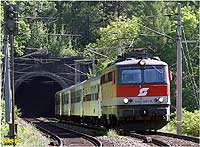 |
|
After
passing the Gamperl viaduct, trains have to pass the Gamperl tunnel.
The uphill exit is visible in the background. The regional stopping
train with loco 1142.691 is climbing up this morning (5/2003). (top
of page) |
|
|
|
|
|
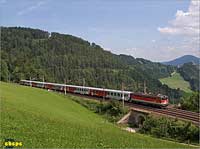 |
|
Side
view of the location like on the image before. Here is one of the
rare sections with open line view, also the line's inclination is
pretty visible. Below of the tracks, the farm Pfefferhof is located
and in the background the little village Klamm with church and castle
ruin (8/2005). |
|
|
|
|
|
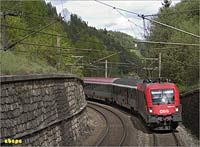 |
|
Now
the Blue Notch. The name comes from blue material which was excavated
here during line construction. Train EC 33 "Allegro Stradivari"
is on tour uphill (5/2005).
|
|
|
|
|
|
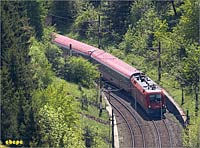 |
|
The
upper end of the Blue Notch is fine visible from the opposite slope.
Train EC 555 "Johann Nestroy" on its way to Villach. Some
few meters later, the track again vanishes behind trees from this
camera position (5/2005).
(top of page) |
|
|
|
|
|
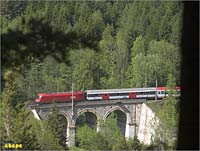 |
|
Between
the Blue Notch and the Weinzettlwand tunnel the Rumpler viaduct is
located. Again EC 33 "Allegro Stradivari" is visible. There
is just one small spot on the hiking trail, where a limited view to
the line is possible between forest trees (5/2005). |
|
|
|
|
|
